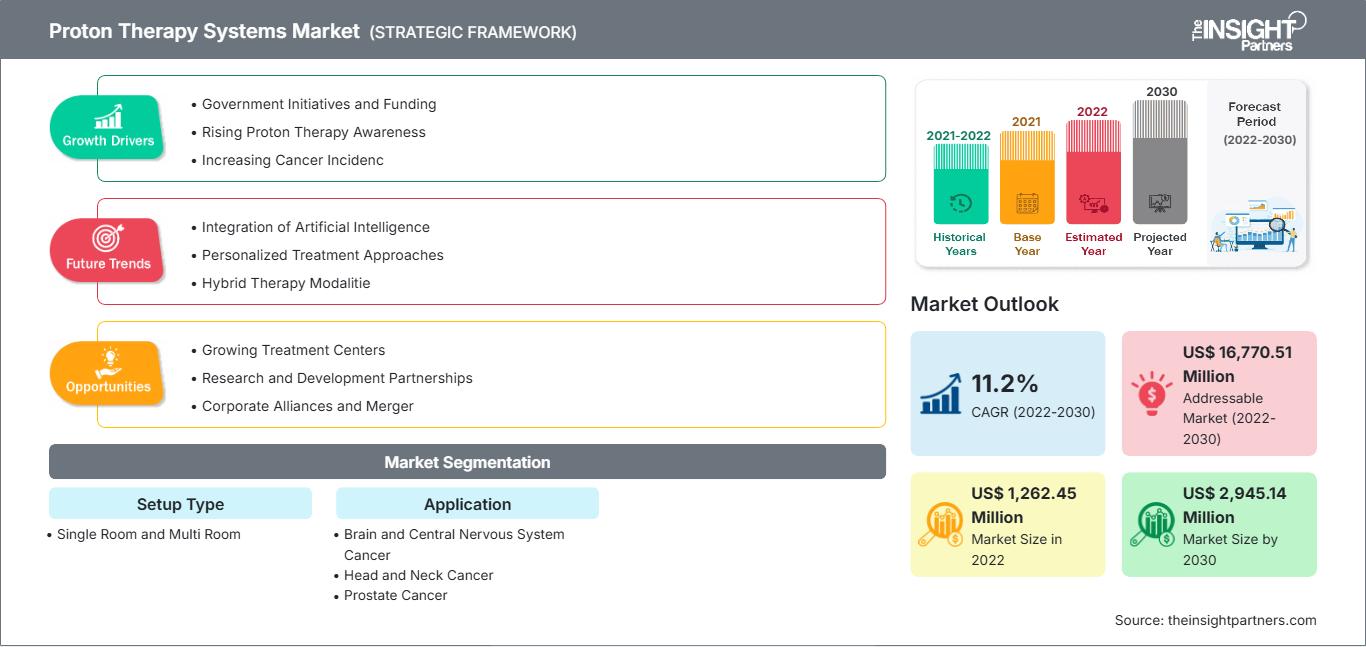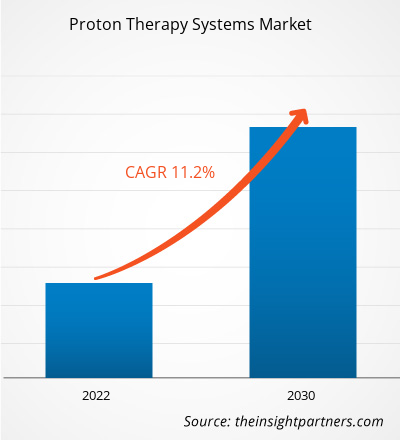[Rapport de recherche] Le marché des systèmes de protonthérapie devrait passer de 1 262,45 millions de dollars américains en 2022 à 2 945,14 millions de dollars américains en 2030 ; il devrait enregistrer un TCAC de 11,2 % entre 2022 et 2030.
Analyses du marché et point de vue des analystes :
Les prévisions du marché des systèmes de protonthérapie peuvent aider les acteurs de ce marché à définir leurs stratégies de croissance.
Un système de protonthérapie est un dispositif médical avancé utilisé pour fournir une radiothérapie de haute précision pour les tumeurs. Ces systèmes sont de grande taille et se composent d'un accélérateur (cyclotron), d'un système de transport de faisceau, d'un système de sélection d'énergie et d'un équipement d'irradiation à portique rotatif. En raison de son efficacité dans le traitement de certains types de cancer, la protonthérapie connaît une demande croissante dans le monde entier. Des facteurs tels que la demande croissante de traitements avancés liée à l'augmentation de l'incidence du cancer et le soutien gouvernemental croissant aux centres de protonthérapie stimulent la croissance du marché des systèmes de protonthérapie. Cependant, le coût élevé et la vaste zone couverte par les systèmes de protonthérapie freinent la croissance du marché. De plus, l'adoption croissante d'approches thérapeutiques personnalisées grâce aux avancées technologiques devrait entraîner de nouvelles tendances sur le marché des systèmes de protonthérapie dans les années à venir.
Moteurs de croissance :
La demande croissante de traitements avancés liée à l'augmentation de l'incidence du cancer stimule la croissance du marché
Selon le Centre international de recherche sur le cancer (CIRC), les cancers du poumon, du sein et de la prostate présentaient les taux d'incidence les plus élevés en 2022. Ces maladies ont un taux standardisé selon l'âge de 23,6, 47,1 et 29,4 cas pour 100 000 habitants, respectivement. Selon les estimations du CIRC, le nombre total de cas de cancer devrait passer de 19,98 millions en 2022 à 23,71 millions en 2030 et à 30,97 millions en 2045. Divers cancers, tels que les cancers de la tête et du cou (nasaux, buccaux, oculaires et laryngés) et les cancers du cerveau, nécessitent des traitements spécifiques, ce qui entraîne une forte demande pour des approches thérapeutiques avancées comme la protonthérapie avec modulation d'intensité (IMPT). Dans les radiothérapies traditionnelles, comme la radiothérapie par rayons X, les tissus sains entourant la tumeur reçoivent également une dose de rayonnement, ce qui entraîne des effets secondaires et peut provoquer des cancers secondaires. Cependant, la protonthérapie contribue au traitement efficace des tumeurs complexes du cerveau et de la région de la tête et du cou, tout en minimisant les dommages collatéraux aux tissus voisins. Ainsi, la forte prévalence du cancer et la demande de traitements avancés stimulent la demande de radiothérapie par protons, alimentant la croissance du marché des systèmes de protonthérapie.
Vous bénéficierez d’une personnalisation sur n’importe quel rapport - gratuitement - y compris des parties de ce rapport, ou une analyse au niveau du pays, un pack de données Excel, ainsi que de profiter d’offres exceptionnelles et de réductions pour les start-ups et les universités
Marché des systèmes de protonthérapie: Perspectives stratégiques

- Obtenez les principales tendances clés du marché de ce rapport.Cet échantillon GRATUIT comprendra une analyse de données, allant des tendances du marché aux estimations et prévisions.
Restriction :
Coût élevé et grande surface des systèmes de protonthérapie
Un système de protonthérapie est un dispositif médical avancé utilisé dans la radiothérapie de haute précision pour les tumeurs. Il s'agit d'un dispositif médical de grande taille composé d'un accélérateur (cyclotron), d'un système de transport de faisceau, d'un système de sélection d'énergie et d'un portique d'irradiation rotatif, ce qui entraîne de grandes surfaces et un coût élevé de l'équipement. Selon l'Université de Pennsylvanie (Oncolink), les cyclotrons des systèmes de protonthérapie pèsent jusqu'à 200 tonnes et ont un diamètre de 1,8 à 4,7 mètres. Le portique peut peser 100 tonnes et avoir un diamètre de 12 mètres. Selon une étude publiée (2021) dans IOPscience, même la conception compacte (configuration à une seule pièce) implique une surface de 100 m², tandis que les systèmes de protonthérapie à plusieurs pièces occupent 200 à 400 m². de superficie.
De plus, les systèmes de protonthérapie nécessitent un investissement important. Par exemple, un système à salle unique peut coûter entre 30 et 50 millions de dollars américains. Le coût des systèmes de protonthérapie à portiques multiples peut débuter à partir de 300 millions de dollars américains et ils ne sont généralement installés que dans les grands hôpitaux et les universités. Par conséquent, les besoins élevés en investissements et les vastes zones d'installation comptent parmi les facteurs qui freinent la croissance du marché des systèmes de protonthérapie.
Segmentation et portée du rapport :
L'analyse du marché des systèmes de protonthérapie a été réalisée en prenant en compte les segments suivants : type d'installation et application.
Par type d'installation, le marché est divisé en salle unique et multi-salles. Le segment des salles multiples détenait une part de marché plus importante des systèmes de protonthérapie en 2022. De plus, le segment des salles individuelles devrait enregistrer un TCAC plus rapide au cours de la période de prévision.
Le marché, par application, est classé en cancer du cerveau et du système nerveux central, cancer de la tête et du cou, cancer de la prostate, cancer du sein, cancer du poumon, cancer gastro-intestinal, etc. Le segment des cancers du cerveau et du système nerveux central détenait la plus grande part de marché des systèmes de protonthérapie en 2022 et devrait enregistrer le TCAC le plus élevé au cours de la période de prévision.
Analyse régionale :
Sur le plan géographique, le rapport sur le marché des systèmes de protonthérapie couvre l'Amérique du Nord, l'Europe, l'Asie-Pacifique, l'Amérique du Sud et l'Amérique centrale, ainsi que le Moyen-Orient et l'Afrique. En 2022, l'Amérique du Nord représentait la plus grande part de marché. L'acceptation et l'adoption croissantes des derniers dispositifs médicaux, la forte prévalence du cancer et les innovations produits des principaux acteurs contribuent à l'expansion du marché des systèmes de protonthérapie en Amérique du Nord. Selon les estimations de l'American Cancer Society, les États-Unis ont enregistré environ 1,95 million de nouveaux cas de cancer et environ 0,61 million de décès liés à la maladie en 2023, ce qui représente une augmentation significative par rapport aux 1,60 million de cas de cancer et 0,60 million de décès signalés en 2020. Selon le Particle Therapy Co-Operative Group, à la fin de 2023, les États-Unis comptaient le plus grand nombre de systèmes de protonthérapie au monde, avec 46 installations de traitement par protonthérapie.
Aperçu régional du marché des systèmes de protonthérapie
Les tendances régionales et les facteurs influençant le marché des systèmes de protonthérapie tout au long de la période de prévision ont été analysés en détail par les analystes de The Insight Partners. Cette section aborde également les segments et la géographie du marché des systèmes de protonthérapie en Amérique du Nord, en Europe, en Asie-Pacifique, au Moyen-Orient et en Afrique, ainsi qu'en Amérique du Sud et en Amérique centrale.
Portée du rapport sur le marché des systèmes de protonthérapie
| Attribut de rapport | Détails |
|---|---|
| Taille du marché en 2022 | US$ 1,262.45 Million |
| Taille du marché par 2030 | US$ 2,945.14 Million |
| TCAC mondial (2022 - 2030) | 11.2% |
| Données historiques | 2021-2022 |
| Période de prévision | 2022-2030 |
| Segments couverts |
By Type d'installation
|
| Régions et pays couverts | Amérique du Nord
|
| Leaders du marché et profils d'entreprises clés |
|
Densité des acteurs du marché des systèmes de protonthérapie : comprendre son impact sur la dynamique des entreprises
Le marché des systèmes de protonthérapie connaît une croissance rapide, portée par une demande croissante des utilisateurs finaux, due à des facteurs tels que l'évolution des préférences des consommateurs, les avancées technologiques et une meilleure connaissance des avantages du produit. Face à cette demande croissante, les entreprises élargissent leur offre, innovent pour répondre aux besoins des consommateurs et capitalisent sur les nouvelles tendances, ce qui alimente la croissance du marché.

- Obtenez le Marché des systèmes de protonthérapie Aperçu des principaux acteurs clés
- Analyse historique (2 ans), année de base, prévision (7 ans) avec TCAC
- Analyse PEST et SWOT
- Taille du marché Valeur / Volume - Mondial, Régional, Pays
- Industrie et paysage concurrentiel
- Ensemble de données Excel
Rapports récents
Témoignages
Raison d'acheter
- Prise de décision éclairée
- Compréhension de la dynamique du marché
- Analyse concurrentielle
- Connaissances clients
- Prévisions de marché
- Atténuation des risques
- Planification stratégique
- Justification des investissements
- Identification des marchés émergents
- Amélioration des stratégies marketing
- Amélioration de l'efficacité opérationnelle
- Alignement sur les tendances réglementaires






















 Obtenez un échantillon gratuit pour - Marché des systèmes de protonthérapie
Obtenez un échantillon gratuit pour - Marché des systèmes de protonthérapie